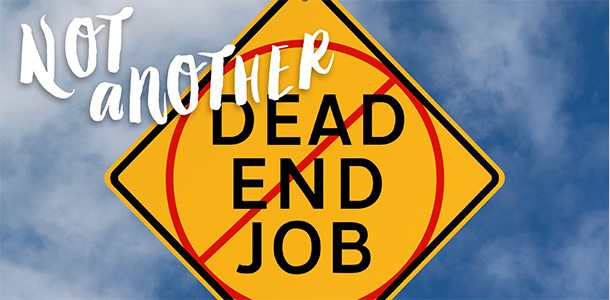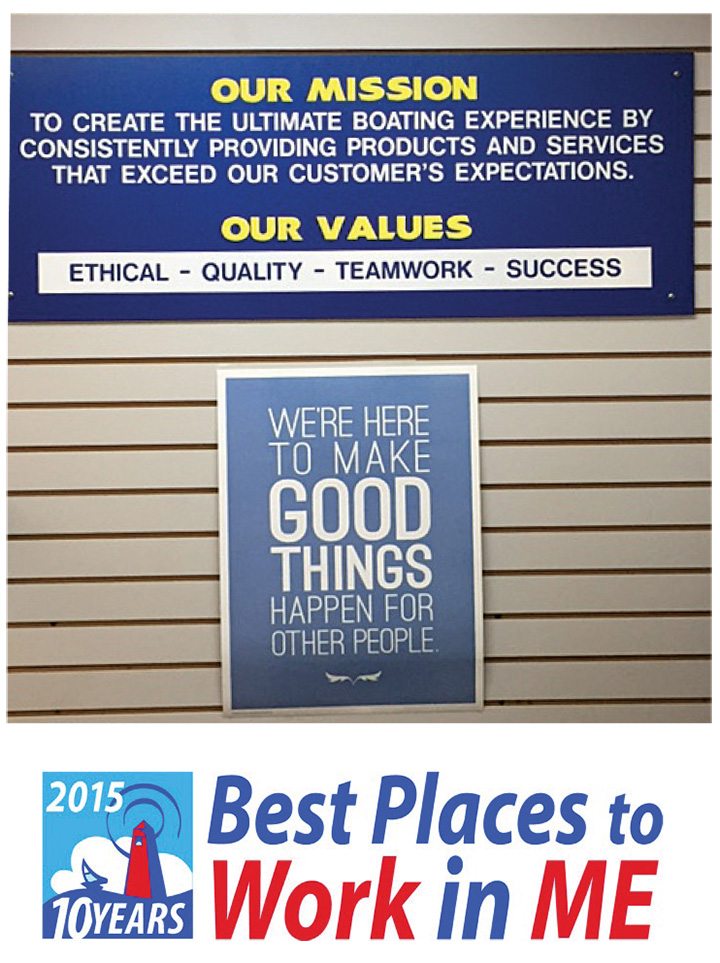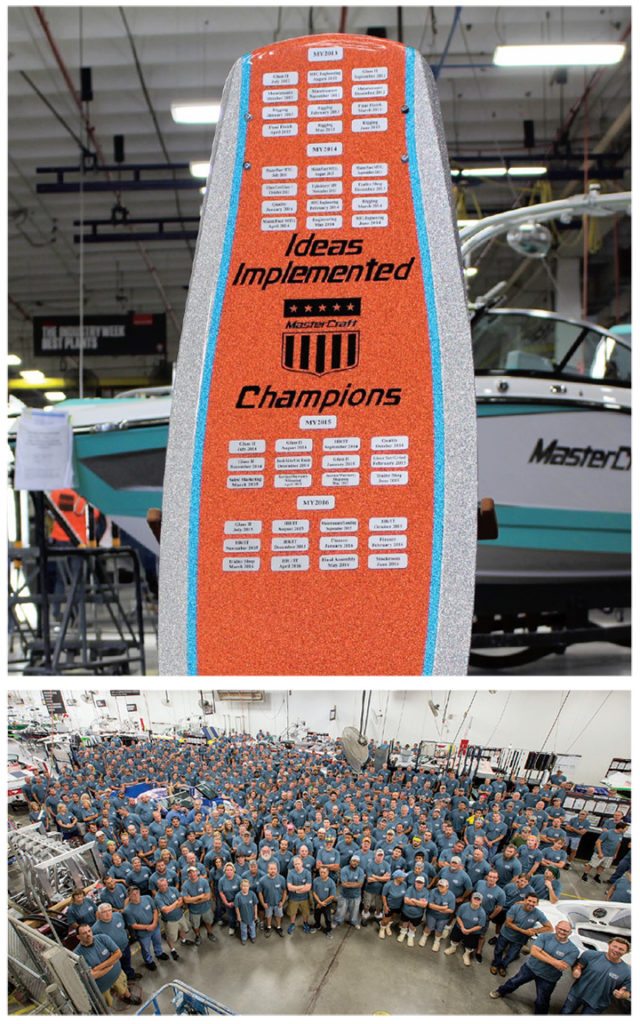Not another dead end job

How to find (and keep) good employees
Any organization worth its salt will tell you its greatest asset is its people. As such, the hiring and retaining on quality employees should be a business’s No. 1 concern.
The boating industry isn’t unaware of the need to hire quality employees – if anything, the industry is hyper aware. But what is the secret to finding the right people, and making sure they stay?
It’s not an easy task, and in many cases it isn’t cheap; it takes a significant investment of time and money. But if you want your business to survive, you need to invest in your people.
A new approach to hiring practices

Because of how the dealership cares for its employees, Port Harbor Marine was selected as one of Maine’s Best Places to Work.
When it comes to hiring, employers need to look beyond the skillset of the candidate and start looking for human qualities first. Will these employees fit into the culture of your business? Will they work hard and believe in the mission of the company? Will they be an enjoyable co-worker?
While there are obviously several advantages to hiring based on experience – a smaller learning curve, less training required – having an employee with a good attitude, good personality and who is a seamless fit into the existing team carries a lot of weight when it comes to finding long-term hires.
“We really start more with the actual person as a person, then as an employee with the experience or skills set they bring to the table. We’re big believers that if you have good people, you’ll be successful and they’ll be able to learn any sort of skills or knowledge that are required. Sometimes we hire people … that don’t necessarily have a lot of experience specifically in the field, position or role that we hired them for,” said Jamie Dewar, general manager of Legend Boats.
At Legends Boats, employees undergo a multi-step screening and interview process, which doesn’t cover the skills and experience necessary for the job until the very end. Once the employee is hired, the company conducts a full orientation for the new person on the first day, as well as months of training and mentoring.
Another option for employers is holding “casting calls” to show job seekers what the business is about, what job opportunities exist within the company and conduct some hands-on training. Legend Boats did this after hearing about it during a Sam Dantzler-led session at the Marine Dealer Conference & Expo, and 70 possible applicants attended. The company is always looking for employees, even when positions aren’t currently available, so that there is an existing pool of options when an opportunity arises. One recent hire at Legend Boats, a parts manager, was interviewed a year prior, when a role wasn’t available. He was a good cultural fit so the dealership called when the position opened.
“If someone did leave where we open up a new position or we’re expanding, we don’t wait until that point to try and hire and then rush into it,” said Dewar. “You don’t want to necessarily be in a position where you need to hire someone because you’re in a difficult, time-sensitive position. You want to have the flexibility to find the perfect person [and not] settle.”

For marine businesses that would rather hire skilled labor from the first, cultivating relationships with local educational institutions is paramount. According to CEO Terry McNew, MasterCraft builds relationships with local universities, which allows the company to identify future graduates who would fit in the company’s open positions in engineering and more. Dealerships and marinas should be cultivating relationships with local high schools, trade schools – particularly marine trade schools – and universities to help find employees and keep a career in boating top of mind with educational institutions.
How to make them stay
“At the end of the day, the thing we repeat here often to our entire team is that you spend more time with the people that you work with than your own family, if you ignore sleep time, so you want to be around people that you like being around. You want to have fun, you want to enjoy what you do,” said Dewar.
One of the easiest ways to keep employees in the company is to invest in their future. This means consistent training, performance evaluations and communication about their long-term goals.
“One of my biggest responsibilities as an owner is to create opportunities for my crewmembers. When I come to work every day, that’s one of the things I’m constantly thinking about,” said Rob Soucy, president of Port Harbor Marine, most recently ranked at No. 7 on the Boating Industry Top 100 and No. 22 on Maine’s “Best Places to Work” for mid-sized businesses. “How can I make everybody better? Because I know as a company, the only way we’re going to get better as a company is if all my crewmembers get better individually.”
At Port Harbor Marine, the leadership works with certain employees to develop a career path. During performance analyses, the manager will discuss the employee’s plans, goals and aspirations for their career and how a future at Port Harbor Marine can achieve those goals.
“It’s a huge challenge but I think the most important thing is that you have that conversation,” said Soucy. “Whether you actually have a detailed path to get there is not as important as having the conversation about” your employee’s personal and professional goals.
In some cases, employees are perfectly happy in their existing role and want to stay there. Soucy makes sure they stay happy in that position by providing training opportunities for those employees to tweak and constantly improve those skills.
“You have other crewmembers [who feel] where they are is where they want to be and they don’t want more responsibility. So then you just try to make them the best crewmember in that position they can be,” Soucy said. “Every crewmember wants to feel that they’re important to the overall business plan, and investing in them is one of the easier ways of doing it.”
“No matter how good someone is at their job, you want to always make sure there’s advancement, improvement, change,” Dewar added. “People tend to, if things get stagnant or repetitive, they get bored, no matter how good they are at their job. There’s kind of this inherent need in humans … to develop, so it’s important to give opportunities.”
The common refrain of “but what if they leave” is a self-fulfilling prophecy: If you don’t invest in your employees, they won’t invest in you.
“The dealers that are worried about training somebody and those people leaving, if they have that concern going into it, then they probably have the wrong person working for them anyway,” said Soucy. “That may sound harsh, but if I have that thought about a person, then I should be questioning whether they’re fully engaged and committed to me to begin with.”
Another reason employees stay is because they value the culture of the company. Creating a formal set of core values for your business helps drive that culture, and your values should be tied to everything you do.
 Soucy believes having a positive culture helps the business keep employees. One of the areas Port Harbor Marine scored the highest in its Maine’s Best Places to Work evaluation was how employees are treated at the company. Many of Soucy’s employees actually drive over an hour to get to work, passing other boat dealerships along the way. Some of his employees aren’t even boaters in their personal time, but they believe in the core values Soucy and his brothers have clearly outlined for the company.
Soucy believes having a positive culture helps the business keep employees. One of the areas Port Harbor Marine scored the highest in its Maine’s Best Places to Work evaluation was how employees are treated at the company. Many of Soucy’s employees actually drive over an hour to get to work, passing other boat dealerships along the way. Some of his employees aren’t even boaters in their personal time, but they believe in the core values Soucy and his brothers have clearly outlined for the company.
“It’s not just about money, it’s not just about benefits – it’s about how you’re treated, how you’re cared for and really believing what the owners and the company are all about,” he said. “You’ve got to look at what type of employer are you and how do you treat your people, and are you creating an environment where they want to be there every day?”
Communicate, communicate, communicate
Employees stay with companies where there is mutual trust between themselves and leadership. The best way to show you trust your employees is to be transparent with them. Communicating regularly about that state of the business, the direction it’s headed and how everyone’s roles play into that success is key.
“We have five meetings a year with everyone in the company: a welcome back meeting when we start the year, and then we have four quarterly meetings. And we talk about where we are as a company and what we’re doing, and we’re open with them,” said Soucy. “We share information so there’s a high level of trust, and they know we’re going to try to do whatever we can for them.”
That communication needs to go both ways. Your employees need to feel empowered to speak up when they see areas for improvement or reoccurring problems. Creating some type of incentive program not only encourages employees to speak up, signaling that you care about their feedback, but it also rewards them for actively participating in the company.

MasterCraft began an Employee Empowerment Program four years ago, which is tied to the company’s “Wildly Important Goals,” or WIGs, which are safety, quality, delivery and cost. Prior to starting this program, “the company was essentially break-even at best and the employees had not been getting regular bonuses or annual pay increases,” said McNew. “So we helped them to understand that we needed their help to turn the business around, and we set up specific goals in each of those areas, and we got tremendous participation.”
Employees across all departments are asked to hit a goal of a certain number of suggestions per months, using scorecards to track progress and help supervisors, managers and employees submit suggestions that are meaningful and actionable. In the first year, MasterCraft received 353 implemented suggestions. In the most recent year, the company received 20,000.
In 2015, MasterCraft won IndustryWeek’s Best Plants award and the Employee Empowerment Program was a key driver to MasterCraft’s selection.
“We’ve nearly doubled production in four years and our net inventories are essentially flat, which is phenomenal. And so it really takes the employees to achieve it,” said McNew. “What they see in it for them is a safe environment. They know that we, the management team, care about them. We’re out on the floor all the time and they see that their ideas are important and getting implemented.”
Legend Boats rewards its employees for Ideas of the Month, which can be anything from ways to save money, increase efficiency or even just fun things to do at the office. Management discusses the ideas and one person wins the Idea of the Month, which comes with a preferred parking spot and a $25 gift card to the restaurant of their choice.
“The best ideas come from the people who are doing the work every day. There’s so many companies that get it wrong and they have their upper management or high-level executives who are making all of the decisions and trying to come up with everything, and typically they don’t know what the issues are as well as the people that are running into the issues every day,” said Dewar. “So I think democratizing that process in order to give everyone a say and the opportunity to voice their opinion, I think that’s crucial.”
Ideas that cannot be implemented right away go into a list to be addressed later. And if an idea comes in that the company can’t implement, the leadership team can provide transparency by discussing why they can’t, and most of the time employees hear the explanation and understand.
“It brings issues to the forefront. So if there is something an employee or team member is frustrated with or unhappy about or a process, a lot of times the ideas come from that unhappiness,” said Dewar. “It allows you to address that unhappiness as well so you can keep your employees happy, and at the same time probably increase efficiency or minimize expense. It’s a win-win situation for everybody.”




